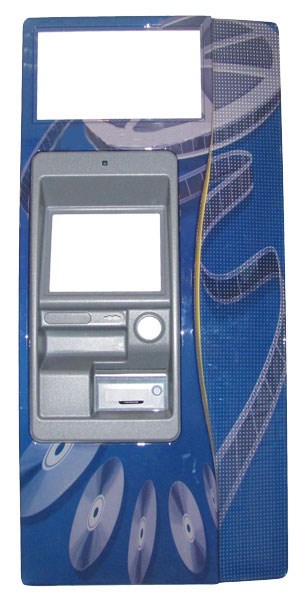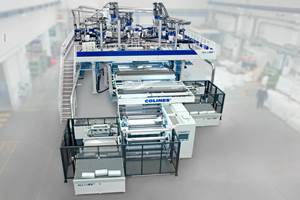On-Site: 'Productive' Is More Than A Name For This Efficient Thermoformer
This processor was ahead of the game by offering value added solutions to clients, then widened the gap further by employing lean management techniques.
It’s better to be lucky than good, so the old saying goes. It’s even better to be both lucky and good.
That’s the story of Productive Plastics Inc., Mt. Laurel, N.J. (productiveplastics.com), a custom manufacturer specializing in heavy-gauge thermoforming—from prototype to production—for markets including lift trucks, medical and other electronic equipment, kiosks, and point-of-purchase displays. Productive Plastics buys sheet from extruders, mostly PVC/acrylic alloys. Approximately 90% of its projects require flame-retardant sheet. Part runs range from 250 pieces to as few as five pieces.
A family-owned company with annual sales in the range of $12 million, Productive started out in 1955 specializing in tooling for foundry and fiberglass applications. By the mid-1970s, the company made the transition to plastics processing. And from the start—well before it became a buzzword—Productive positioned itself as a solutions provider as opposed to a parts maker, even though making parts was probably sufficient to turn a profit in those days.
“Right off the bat, we knew we didn’t want to be in commodity thermoforming,” says Hal Gilham, president and CEO. “We were not going to sell based on the cheapest price. Instead, our mission was and is to provide added value in the components—not parts—we supply to customers. We think we were ahead of the game in that respect.”
Innovation has been a theme at Productive throughout its history. In the 1980s it added pressure-forming capability, offering parts with better aesthetics, more complex designs, and lower upfront tooling costs. In 1985 it brought multi-axis CNC routing in house. In the 1990s, when OEMs began to push processors to get involved early in the design phase and embrace “art-to-part” development, Productive added rapid prototyping and CAD/CAM technology.
Today, Gilham says, the thermoformer is moving rapidly toward turnkey capabilities, to such an extent that it is looking at expanding into structural foam/injection molding so that it can exercise greater control over assemblies that require both molded and thermoformed parts. It also purchased Sensigraphics (sensigraphics.com), a membrane-switch company, which has been integrated into the Productive operation in Mt. Laurel. “Customers in all of our markets are looking at waste within the entire value stream. Many are consolidating their suppliers. If we can provide them, for example, with a single assembly containing a thermoformed part, an injection molded part, a sheet-metal part, and an electronics component, we are allowing them to do exactly that.”
WASTE NOT
The company has recently become a disciple of the Toyota Production System (TPS). Developed by Toyota Motor Corp. after World War II, the idea behind TPS is to wring waste out of the process in order to provide clients with the best quality and lowest cost at the shortest lead time. The TPS concept addresses seven types of waste:
1. Over-production;
2. Motion (of operator or machine);
3. Waiting (of operator or machine);
4. Conveyance;
5. Processing itself;
6. Inventory (raw material);
7. Correction (rework and scrap).
“TPS is our foundation for lean manufacturing,” states Evan Gilham, Productive’s vp of manufacturing and Hal’s son. A company adopting TPS views its manufacturing process through the eyes of its customers. At Productive, each of its six thermoforming cells are designed with in-process quality inspection and sampling. “Before, we used to bring parts over to a central area of QC and inspection, and we’d wind up running quite a few parts before we realized we had a problem,” says Evan Gilham.
“We strive for a continuous, smooth flow,” he continues. “We arrange our equipment to allow for this. We count the time it takes an operator to move a part throughout the cell—for instance, from the thermoformer to the trimming station. On one project, we reduced the time it took to make a finished part from 14 minutes down to 8 minutes.
“Waste can also be manifested in over-engineering. We ask what a part requires in terms of material usage and wall thickness.”
Productive Plastics got into TPS at the urging of a customer that builds electric forklift trucks. This company was among the first benefactors of the thermoformer’s move to more customer-centric manufacturing. Productive Plastics had been providing eight key components for the customer’s largest-volume lift-truck line, but growth in demand was outstripping the customer’s production capacity.
The forklift manufacturer determined that its challenge in meeting customer demand for the vehicle was costing at least 10% of the potential growth in the product line. In addition, the firm was carrying $90,000/month in plastic parts inventory, tying up scarce capital. And the need to allocate more than 150 locations for parts inventory occupied precious floor space that could be otherwise used to expand production.
Productive proposed that it take responsibility for “kitting”—or grouping as one unit—the eight thermoformed parts for that product line, as well as holding the inventory and delivering kits on a daily demand basis, with ordering and tracking supported by a modest modification in its IT system.
The kitting program allowed the forklift maker to fulfill an anticipated 20% increase in vehicle sales, slashed $77,000/month in its inventory expenses, eliminated 136 inventory locations, and resulted in a 25% increase in production efficiency due to product being delivered daily in production-line sequences.
Another example of lean manufacturing in action involved a world leader in medical devices and diagnostic instrumentation. This company was having a delivery problem with a previous supplier of custom enclosures for a top-selling product line. The OEM was getting many parts more than six weeks late. It did not have the infrastructure to support JIT (Just in Time) delivery.
These problems were reducing the company’s revenues by more than 15% for five consecutive months and were beginning to sully its reputation. The medical OEM approached Productive Plastics to see what could be done. The OEM had previously used Productive, but due to pricing pressures on this critical product line had decided to switch to another thermoformer that was offering a lower purchase price.
Productive Plastics proposed a plan involving access to the OEM’s web-based forecasting schedule. This would allow the thermoformer to see the customer’s short-term needs for delinquent parts, purchase raw materials, and block out production capacity prior to moving any tooling.
As tooling for critical parts moved to Productive Plastics, parts were being made within 48 hr of receipt. Because of Productive Plastics’ lean manufacturing methods, it was able to run smaller lot sizes economically, which allowed it to fulfill back orders created by the previous supplier within 45 days.
Not only was the customer back on track for parts deliveries, and thereby realizing an additional 15% of monthly revenue, but Productive Plastics’ willingness to make smaller lot sizes cut the customer’s inventory by 60% for the custom enclosures required on this product line.
“With better controls over our entire process, we have been able to carve a niche for ourselves in higher-value end markets,” Hal Gilham states. ‘We’re not necessarily going to be the cheapest, but the value we are able to bring to the table translates into substantial cost savings for our customers in the big picture. We have 55 people who work here and about 80,000 ft² of manufacturing space. Most other companies in our business with our sales volume require twice as many people and double the space to do what we can.”
Related Content
In Sustainable Packaging, the Word is ‘Monomaterial’
In both flexible and rigid packaging, the trend is to replace multimaterial laminates, coextrusions and “composites” with single-material structures, usually based on PE or PP. Nonpackaging applications are following suit.
Read MoreYoung Stretch-Film Processor Bets on Nanolayers
Going up against companies with as much as double its capacity, young stretch-film processor Zummit believes that new technology — notably 59-nanolayer films — will give it a competitive edge.
Read MoreFormulating LLDPE/LDPE Blends For Abuse–Resistant Blown Film
A new study shows how the type and amount of LDPE in blends with LLDPE affect the processing and strength/toughness properties of blown film. Data are shown for both LDPE-rich and LLDPE-rich blends.
Read More‘Monomaterial’ Trend in Packaging and Beyond Will Only Thrive
In terms of sustainability measures, monomaterial structures are already making good headway and will evolve even further.
Read MoreRead Next
Lead the Conversation, Change the Conversation
Coverage of single-use plastics can be both misleading and demoralizing. Here are 10 tips for changing the perception of the plastics industry at your company and in your community.
Read MorePeople 4.0 – How to Get Buy-In from Your Staff for Industry 4.0 Systems
Implementing a production monitoring system as the foundation of a ‘smart factory’ is about integrating people with new technology as much as it is about integrating machines and computers. Here are tips from a company that has gone through the process.
Read More
















.png;maxWidth=300;quality=90)














